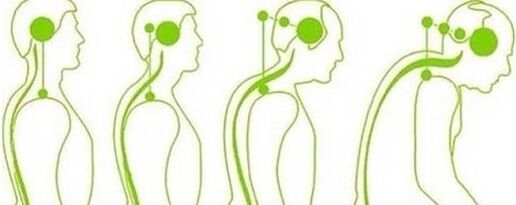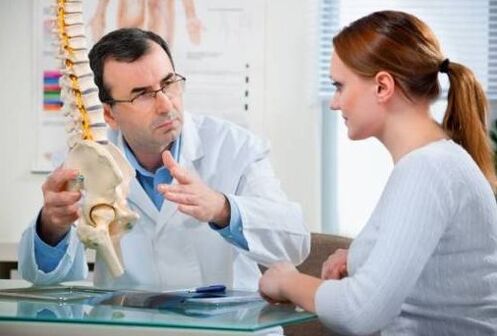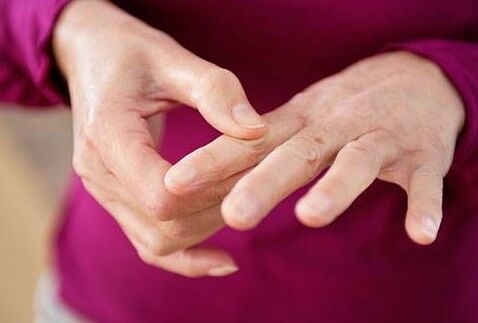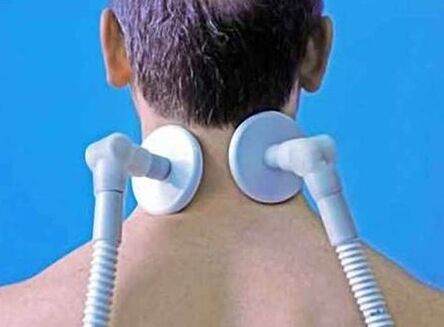Cervical osteochondrosis develops most often in adults, but due to certain conditions, children may occur. When any signs of this disease appear, you should contact a therapist or a specialist in the stenosis A neurologist.

Degenerative nutritional destruction of the cervical disc of the spine characterizes the cervical bone cartilage. The gradual progression of the disease can lead to damage to the vertebrae, adjacent vertebrae and ligaments. Many people mistakenly believe that osteochondrosis is the deposition of salt. However, such statements are fundamentally wrong. Salt can indeed be deposited in various joints, but due to the development of gout, such as other pathology.
Thanks to the muscular system, the backbone of the human neck consisting of seven vertebrae. In this area, muscle dysplasia occurs, fatigue and spasms due to long-term tension. In the future, the mobility of the cervical spine will become limited. As a result of this, the spinal disk was gradually destroyed, which caused the beginning of the first phase of osteochondrosis. Without treatment, the disease continues to develop, leading to all larger lesions in the spine. To prevent the development of complications, it is necessary to pay attention to the first sign of timely pathology and take appropriate measures.
In most cases, people like cervical osteochondrosis face the least physical exercise and sedentary work of people’s lifestyle. Among such people, the possibility is the greatest, and the first function can be shown at the age of 25-30. This disease is less common in children from infants to puberty, but can also occur due to incorrect lifestyle or hereditary and other irritating factors.
The stages of pathological development and its inherent symptoms
The entire process of cervical osteocartilage degeneration is divided into 4 main stages, each stage is accompanied by certain symptoms. Treatment depends entirely on the determined severity of the disease. For example, the first preclinical stage does not require medication. To improve the patient's condition, it is recommended to fundamentally check your lifestyle - perform physical exercise and eat correctly. Characteristics of this stage: excessive tension of the entire back muscles, rapid emergence of fatigue sensation, and obvious but tangible pain in the moment of turning and the moment and inclination of the head. In this case, the main drawback can distinguish the fact that few people deal with the importance of such symptoms and therefore they do not immediately turn to the hospital.

The following symptoms are second degree - characteristics of osteocartilage:
- The pain becomes more intense when moving the head and gives in to the shoulders, hands, and even the lower back regularly;
- Pain syndrome can occur in a calm state;
- Have irrelevant headaches;
- Distracted attention and reduced work ability.
Therefore, none of the above symptoms can continue to be noticed, so in most cases, at this stage of the disease, patients seek medical help. Strengthening pain is due to a reduced distance between the disc and nerve erosion. A greater intensification occurred in the third phase. In this case, pain in the neck continues to bother and numbness of the muscles of the hands from time to time. As for general symptoms, dizziness and weakness become daily companions of patients. The cervical spine is inactive.
The advent of the neck, shoulders, arms, ears in the ears, the coordination of total damage, and the obvious signs of other diseases indicate the beginning of the last fourth stage of osteochondria. At the same time, the intervertebral disc is damaged and the pathological process moves further along the spine, affecting other departments. The degree of this disease is difficult to treat and is determined by the doctor and may require surgical intervention. Therefore, symptoms: soreness in the neck and tightening during head movement, hands, dizziness, nausea, headache, hands, fatigue, and coordination problems should become a shocking signal of actual health problems. Do not delay visiting a doctor, it is best to contact the therapist or contact a neuropathologist immediately.
During the progression of cervical osteochondrosis, spinal erosion may occur. Different sensitivity and movement disorders may occur depending on the spine being subjected to:
- partially or completely lost sensitivity in any part of the neck, shoulders, and arms;
- Pain in any area of the neck, shoulders, forearms, hands, finger tips;
- Numbness of language, which is why speech is damaged;
- The muscle tone of the head and neck is reduced;
- Problems with respiratory function, heart and liver pain.

The protruding edge of the vertebrae can squeeze blood into the arteries of the brain. Therefore, blood circulation in the brain is disturbed and other symptoms appear: rapid changes in emotions, insomnia, harmless anxiety, fear, irritability. At the same time, with vasospasm, not only headaches, but also eye pain. Patients often notice the appearance of "flies" in their eyes and may sometimes faint.
Causes of the development of cervical osteochondrosis
The most common cause of cervical osteochondrosis is considered a sedentary lifestyle that combines with improper, unbalanced nutrition. Often, not only are lazy people suffering from their nature, but those professions that have to be spent most of the time or in the same uncomfortable position: office staff, vehicle drivers, etc. This lifestyle raises an ongoing burden on the cervical vertebrae, which is why muscle spasms occur. The emergence of degeneration in the intervertebral disc is due to violations of metabolic processes and blood circulation. Other causes of developing cervical osteochondrosis include:
- Unhealthy nutrition produces too much weight;
- Rheumatism, scoliosis, posture problems, flat feet;
- Trauma in the spine and neck;
- Regular pressure, nerve overvoltage;
- Genetic reasons;
- Improper development of the cervical vertebrae.
Overly enthusiastic exercise, which means that excessively intense physical activity can also be a predecessor in cervical osteochondrosis. The main disease in this case is usually the intervertebral disc. The latter is a malnutritional disease in the intervertebral disc (mainly inconsistent with the lumbar spine and cervix). In this case, osteocartilage is the result of the disc. In addition to excluding a lot of physical fatigue, complex, drug and physical therapy treatments are also required.

Consequences of progressive pathology
The possible complications of osteochondrosis in the cervical area should be distinguished:
- Due to the rapid development of the underlying disease, hernia and protrusion in spinal can be formed in the third and fourth stages.
- The growth of bone tissue or the formation of bone plants - usually the prerequisite for protrusions. Bone plants have a stimulating effect on nearby muscles, thereby increasing their tone. Therefore, the pressure on the disc increases. Additionally, educated bone plants can cause narrowing of arteries.
- Flattening of the spinal disc - The decrease in the vertebrae causes a decrease in height between the discs, and the risk of the cervical vertebrae having a hemi-cartilage increases dramatically with the head;
- The displacement of the spine or spinal disc is not as frequent as other complications of the above complications, but, in the event of occurrence, even death can lead to death. Any minimal change in disc position changes will result in paralysis, and more importantly, displacement - death.
Cervical osteochondrosis always causes an increase in blood pressure. Furthermore, the potential disease transitions from one stage to another, leading to the development of hypertension from the first to the third stage, to which point the stress exceeds the 180 mm mark. Direct treatment of hypertension can help reduce the severity of symptoms, but only temporarily. Without cured osteochondrosis, it is impossible to get rid of elevated blood pressure. In disc injury (complications) between the 4 and 5 cervical spines, peripheral arthritis occurs. It characterizes the pinching of nerves located between the shoulder joint and the hand. At the same time, severe pain occurred on the shoulder, which negatively affected the movement of the entire limb. Similarly, the manifestations of osteochondrosis cannot be based on signs of heart disease, such as angina, but due to diagnostic measures, the disease can be distinguished with high accuracy.
Due to visual medical examination, it is impossible to determine osteochondrosis in the cervical spine through palpation. Based on the collected medical history, doctors can only assume that precise osteocartilage becomes the cause of certain symptoms. To confirm or refute this assumption, a diagnosis is required. The best approach today is MRI or magnetic resonance therapy. This approach allows you to consider all bone structures, determine the presence of vertebral hernia, the size of bone plants, and the characteristics of other complications, which are traits of cervical osteochondrosis. Computed tomography is another way to have slightly informative content. It allows you to determine the determination of the diagnosis, as its presence can be difficult.

Treatment of cervical bone and chondropathy
The treatment of osteochondrosis in the cervical area is always complex and complex. Its duration and saturation depend on the stage of the disease development, the individual characteristics of the patient, and the presence of other accompanying diseases. In the main drug groups that are usually prescribed in the second and further stages, distinction should be made:
- Pain analgesics or painkillers. The funds listed help to temporarily relieve pain. Novicaine local blockade was used because the pain was too obvious.
- NSAIDs and steroid anti-inflammatory drugs. Nonsteroids are safer and have analgesic effects and can become a substitute for common analgesics. If they don't relieve pain, use steroid medication.
- Antidepressants and sedatives - mother, valerian tin agent. Their purpose is caused by two factors: if the cause of osteochondrosis is a neurologic technique, or the pain is so severe that it has a negative psychological impact. Since each drug has many contraindications and can become addictive, such drugs should be used under strict observation.
- Muscle mobility agent that helps relieve muscle cramps. In combination with anti-inflammatory drugs, they have analgesic effects.
- Vascular metastasis agent that helps improve blood circulation.
- Drugs that increase immunity and standardize the metabolic process are ideal for B and C vitamins.
The complex of these drugs is a symptomatic treatment. Following all the doctor’s advice and passing the prescribed course will help eliminate pain and get rid of all unpleasant manifestations of the disease. However, the treatment course is not over. When eliminating the main characteristics can aggravate the quality of life, you can restore the cervical area to minimize the risk of disease recurrence in the near future. Unfortunately, a huge mistake for many people is that after the symptoms go away, they think they are completely healthy and give up treatment. In this case, osteochondrosis will surely remind yourself after a while.
Physical Therapy and Traditional Medicine
The following physical therapy procedures are successfully used to treat cervical osteochondrosis:

- Medical Physical Education - Performed only under the supervision of qualified experts, as incorrect exercise may harm tissue in severe disc lesions.
- Manual therapy - is a manual effect on certain parts of the patient's body;
- Treatment massage;
- Reflexology, as a type of acupuncture;
- Electrophoresis, Barney therapy, laser therapy, UFO, etc.
Each of the above procedures has many contraindications, which are especially important for those who have disbanded other diseases that are not related to the cervical vertebrae bone. The principal physician still has a decision on the appropriateness of using a specific method. It may be unsafe to implement such measures of your own free will. As for traditional medicines, you can use the grass of knife meat. The figure also suggests reducing salt intake. The responsible approach to the treatment of cervical osteochondrosis can certainly get rid of the disease. Let this process take a lot of time, but only complex therapies can minimize the chances of disease development.

























